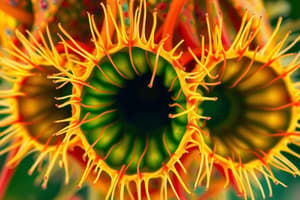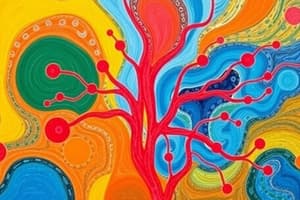Podcast
Questions and Answers
What is the main function of the medial vestibulospinal tract (MVST)?
What is the main function of the medial vestibulospinal tract (MVST)?
- Controlling head and neck positions (correct)
- Coordinating limb movements
- Balancing the body
- Controlling eye muscles
Which vestibular nuclei is the largest and projects via the medial longitudinal fasciculus?
Which vestibular nuclei is the largest and projects via the medial longitudinal fasciculus?
- Medial Vestibulospinal Tract (MVST)
- Oculo-motor Nucleus
- Inferior Vestibular Nucleus (IVN)
- Superior Vestibular Nucleus (SVN) (correct)
What is the purpose of the vestibulo-ocular reflex (VOR)?
What is the purpose of the vestibulo-ocular reflex (VOR)?
- Maintaining balance
- Controlling limb movements
- Adjusting eye movements for changes in head positions (correct)
- Regulating breathing rate
Which pathway mediates the vestibulo-ocular reflex (VOR) by adjusting eye movements for head motions?
Which pathway mediates the vestibulo-ocular reflex (VOR) by adjusting eye movements for head motions?
What is the purpose of Frenzel glasses in vestibular examinations?
What is the purpose of Frenzel glasses in vestibular examinations?
Why is Video-nystagmography/Vide-oculography used in vestibular testing?
Why is Video-nystagmography/Vide-oculography used in vestibular testing?
What does the Head Impulse Test (HIT) primarily stimulate during vestibular testing?
What does the Head Impulse Test (HIT) primarily stimulate during vestibular testing?
What does COWS stand for in the context of vestibular testing?
What does COWS stand for in the context of vestibular testing?
Why is a Rotating Chair Test conducted during vestibular examination?
Why is a Rotating Chair Test conducted during vestibular examination?
What happens when hot water is introduced into the ear during vestibular testing?
What happens when hot water is introduced into the ear during vestibular testing?
What happens when hair cells are bent towards the kinocilium?
What happens when hair cells are bent towards the kinocilium?
What is the role of otoliths in the vestibular system?
What is the role of otoliths in the vestibular system?
Which nucleus is responsible for controlling balance and extensor tone in limbs?
Which nucleus is responsible for controlling balance and extensor tone in limbs?
Which direction will fluid move if there is rapid acceleration to the left?
Which direction will fluid move if there is rapid acceleration to the left?
What is the effect when hair cells project towards the utricle?
What is the effect when hair cells project towards the utricle?
Which nucleus primarily contributes to the Medial Vestibular Nucleus (MVN)?
Which nucleus primarily contributes to the Medial Vestibular Nucleus (MVN)?
What do the maculae of the utricle and saccule detect?
What do the maculae of the utricle and saccule detect?
'Turning head to the left is a _____ acceleration of the head.' Fill in the blank.
'Turning head to the left is a _____ acceleration of the head.' Fill in the blank.
'Otoliths give mass as they are made up of ______.' Fill in the blank.
'Otoliths give mass as they are made up of ______.' Fill in the blank.
'Hair cell receptors have axons projecting to cell bodies in ______.' Fill in the blank.
'Hair cell receptors have axons projecting to cell bodies in ______.' Fill in the blank.
Study Notes
Vestibular Pathways
- Medial vestibulospinal tract (MVST) is a medial descending motor system that only extends to the cervical spine and is important for controlling head and neck positions (vestibulo-collic reflexes).
- The largest vestibular nucleus is the Superior Vestibular Nucleus (SVN), followed by the Inferior Vestibular Nucleus (IVN).
Medial Longitudinal Fasciculus (MLF)
- MLF is a pathway that connects the SVN and MVN to the oculomotor nucleus, trochlear nucleus, and abducens nucleus.
- MLF is responsible for controlling eye muscles and reflexes, particularly the vestibulo-ocular reflex (VOR).
- VOR adjusts eye movements to compensate for changes in head positions, ensuring clear vision during head movements.
Vestibular Nuclei Outputs
- Thalamus: projects to the cortex, transmitting information about head orientation and movement.
- Cerebellum: receives ipsilateral projections from the vestibular nuclei, contributing to balance and coordination of movements.
- Cortex: receives conscious perception of head orientation and movement via the thalamus.
Vestibulo-Ocular Reflex
- Eyes move in the opposite direction of head movement (same direction as cupula).
- Eye movements are adjusted for changes in head position to maintain a stable line of sight.
Nystagmus
- Continual vestibular stimulation leads to nystagmus (beating eyes).
- Frenzel glasses: remove visual fixation during vestibular examination, allowing for observation of nystagmus.
- Electronystagmography (ENG): measures changes in the electrical field within the eye to detect nystagmus.
- Video-nystagmography/Vide-oculography: uses infrared sensors to record eye movements and measure nystagmus.
Measuring Nystagmus
- Rotating chair test: tests horizontal canal function by rotating the patient in a chair.
- Head impulse test (HIT): tests canals in all planes, stimulating the acoustic nerve with cold or warm water or air.
Hair Cells and Vestibular Function
- Hair cells are like a tap that leaks a small amount of neurotransmitter onto the 8th nerve afferents.
- Bending the cilia either increases (depolarization) or decreases (hyperpolarization) the leak, affecting impulse frequency.
- Excitation of hair cells: pushing towards the kinocilium increases impulse frequency.
- Inhibition of hair cells: pushing away from the kinocilium decreases impulse frequency.
Semicircular Canals and Otolith Organs
- Semicircular canals detect angular acceleration.
- Otolith organs (utricle and saccule) detect linear acceleration and effects of gravity due to movement.
- Maculae of the organs detect linear acceleration and head tilt, transmitting information to the vestibular nerves.
Vestibular Nuclei
- Lateral Vestibular Nucleus (LVN): Deiters' nucleus, controls balance and extensor tone in limbs, extends throughout the spinal cord.
- Medial Vestibular Nucleus (MVN): arises from the medial vestibular nucleus with additional contributions from the inferior vestibular nucleus.
Studying That Suits You
Use AI to generate personalized quizzes and flashcards to suit your learning preferences.
Description
Learn about the function of hair cells in the inner ear, how they respond to bending of cilia, and the role of semicircular canals in detecting angular acceleration. Explore how hair cells are involved in depolarization and hyperpolarization to transmit signals to the brain.




